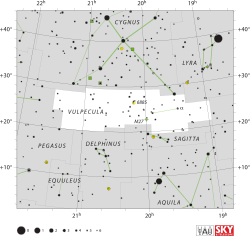2 Vulpeculae
2 Vulpeculae, som är stjärnans Flamsteed-beteckning, är en dubbelstjärna[14] belägen i den mellersta delen av stjärnbilden Räven, som också har variabelbeteckningen ES Vulpeculae. Den har en genomsnittlig skenbar magnitud på ca 5,43[3] och är svagt synlig för blotta ögat där ljusföroreningar ej förekommer. Baserat på parallax enligt Gaia Data Release 2 på ca 1,8[1] mas, beräknas den befinna sig på ett avstånd på ca 1 800 ljusår (ca 570 parsek) från solen. Den rör sig bort från solen med en heliocentrisk radialhastighet av ca 1 km/s.[3]
| 2 Vulpeculae | |
 | |
| Observationsdata Epok: J2000.0 | |
|---|---|
| Stjärnbild | Räven |
| Rektascension | 19t 17m 43,6353s[1] |
| Deklination | +23° 01′ 31,9399″[2] |
| Skenbar magnitud () | +5,43 (V)[3], +5,42 (maximum) – 5,48 (minimum) (V)[4][5] |
| Stjärntyp | |
| Spektraltyp | B1 IV[6] |
| B–V | -0,020 ± 0,003[3] |
| Variabeltyp | Beta Cephei-variabel (BCEP)[4][7] |
| Astrometri | |
| Radialhastighet () | 1,00 ± 4,2[6] km/s |
| Egenrörelse (µ) | RA: +1,032± 0,151[1] mas/år Dek.: -6,518 ± 0,165[1] mas/år |
| Parallax () | 1,7660 ± 0,1088[1] |
| Avstånd | 1 800 ± 100 lå (570 ± 30 pc) |
| Absolut magnitud () | -2,35[3] |
| Detaljer | |
| Massa | 12,5 ± 0,6[8] M☉ |
| Radie | 10,95[9] R☉ |
| Luminositet | 21 922[10] L☉ |
| Temperatur | 26 850[10] K |
| Metallicitet | -0,06 ± 0,10 (Fe/H)[11] dex |
| Vinkelhastighet | 270[12] km/s |
| Ålder | 12,6 ± 0,7[8] miljoner år |
| Andra beteckningar | |
| ES Vul, GC 26613, IDS 19135+2251 A, SAO 87036, GCRV 11751, IRAS 19156+2255, SKY# 35819, BU 248A, GEN# +1.00180968J, LS II +22 3, TD1 24364, ADS 12287 A, GSC 02124-02557, 2MASS J19174364+2301319, TYC 2124-2557-1, AG+22 1930, HD 180968, MCW 729, UBV M 23653, ALS 10239, HIC 94827, N30 4271, uvby98 100180968, BD+22 3648, HIP 94827, PPM 108726, WDS J19177+2302A, CCDM J19177+2302A, HR 7318, ROT 2764, YZ 22 6936[2][13] | |
Egenskaper redigera
Primärstjärnan 2 Vulpeculae A är en blå till vit underjättestjärna av spektralklass B1 IV[6] och en snabbt roterande Be-stjärna.[15] Den har en massa som är ca 13[8] solmassor, en radie som är ca 11[9] solradier och utsänder ca 21 900[16] gånger mera energi än solen från dess fotosfär vid en effektiv temperatur på ca 26 800 K.[10]
2 Vulpeculae är en pulserande variabel av Beta Cephei-typ (BCEP),[4] som varierar i magnitud +5,42 - +5,48, med en period av 0,6096 dygn eller 14,63 timmar.[4]
2 Vulpeculae är en dubbelsidig spektroskopisk dubbelstjärna,[14][16] som år 2002 hade en vinkelseparation av 1,72 bågsekunder vid en positionsvinkel av 127,2°.[17]
Se även redigera
Referenser redigera
- Den här artikeln är helt eller delvis baserad på material från engelskspråkiga Wikipedia, 2 Vulpeculae, 26 augusti 2020.
Noter redigera
- ^ [a b c d e] Brown, A. G. A.; et al. (Gaia collaboration) (August 2018). "Gaia Data Release 2: Summary of the contents and survey properties". Astronomy & Astrophysics. 616. A1. arXiv:1804.09365. Bibcode:2018A&A...616A...1G. doi:10.1051/0004-6361/201833051. Gaia DR2 record for this source at VizieR.
- ^ [a b] ”Basic data: V* 2 Vul – Variable Star of Beta Cephi type” (på engelska). Centre de Données astronomiques de Strasbourg. http://simbad.u-strasbg.fr/simbad/sim-basic?Ident=2+Vul&submit=SIMBAD+search. Läst 13 februari 2016.
- ^ [a b c d e] Anderson, E.; Francis, Ch. (2012). "XHIP: An extended hipparcos compilation". Astronomy Letters. 38 (5): 331. arXiv:1108.4971. Bibcode:2012AstL...38..331A. doi:10.1134/S1063773712050015.
- ^ [a b c d] ”ES Vul” (på engelska). The International Variable Star Index. AAVSO – American Association of Variable Star Observers. http://www.aavso.org/vsx/index.php?view=detail.top&oid=38337. Läst 13 februari 2016.
- ^ Samus N.N., Durlevich O.V., Kazarovets E V., Kireeva N.N., Pastukhova E.N., Zharova A.V. med flera. ”General Catalogue of Variable Stars, 4th Edition, Volumes I-III” (på engelska). http://www.sai.msu.su/gcvs/cgi-bin/search.cgi?search=ES+Vul. Läst 13 februari 2016.
- ^ [a b c] Rountree, Janet; Sonneborn, George (1991). "Criteria for the spectral classification of B stars in the ultraviolet". Astrophysical Journal. 369: 515. Bibcode:1991ApJ...369..515R. doi:10.1086/169781.
- ^ Samus, N. N.; et al. (2017). "General Catalogue of Variable Stars". Astronomy Reports. 5.1. 61 (1): 80–88. Bibcode:2017ARep...61...80S. doi:10.1134/S1063772917010085.
- ^ [a b c] Tetzlaff, N.; Neuhäuser, R.; Hohle, M. M. (January 2011). "A catalogue of young runaway Hipparcos stars within 3 kpc from the Sun". Monthly Notices of the Royal Astronomical Society. 410 (1): 190–200. arXiv:1007.4883. Bibcode:2011MNRAS.410..190T. doi:10.1111/j.1365-2966.2010.17434.x.
- ^ [a b] https://www.universeguide.com/star/94827/2vulpeculae. Hämtad 2020-08-26.
- ^ [a b c] Hohle, M. M.; et al. (2010). "Masses and luminosities of O- and B-type stars and red supergiants". Astronomische Nachrichten. 331 (4): 349–360. arXiv:1003.2335. Bibcode:2010AN....331..349H. doi:10.1002/asna.200911355.
- ^ Gáspár, András; et al. (2016). "The Correlation between Metallicity and Debris Disk Mass". The Astrophysical Journal. 826 (2): 171. arXiv:1604.07403. Bibcode:2016ApJ...826..171G. doi:10.3847/0004-637X/826/2/171.
- ^ Abt, Helmut A.; et al. (July 2002). "Rotational Velocities of B Stars". The Astrophysical Journal. 573 (1): 359–365. Bibcode:2002ApJ...573..359A. doi:10.1086/340590.
- ^ "2 Vul". SIMBAD. Centre de données astronomiques de Strasbourg. Hämtad 2019-03-12.
- ^ [a b] Chini, R.; et al. (2012). "A spectroscopic survey on the multiplicity of high-mass stars". Monthly Notices of the Royal Astronomical Society. 424 (3): 1925–1929. arXiv:1205.5238. Bibcode:2012MNRAS.424.1925C. doi:10.1111/j.1365-2966.2012.21317.x.
- ^ Balona, L. A. (December 1995). "Tests of the Pulsation and Starspot Models for the Periodic Be-Stars". Monthly Notices of the Royal Astronomical Society. 277 (4): 1547. Bibcode:1995MNRAS.277.1547B. doi:10.1093/mnras/277.4.1547.
- ^ [a b] Brown, A. G. A.; et al. (Gaia collaboration) (August 2018). "Gaia Data Release 2: Summary of the contents and survey properties". Astronomy & Astrophysics. 616. A1. arXiv:1804.09365. Bibcode:2018A&A...616A...1G. doi:10.1051/0004-6361/201833051. Gaia DR2 record for this source at VizieR.
- ^ Roberts, Lewis C., Jr. (May 2011). "Astrometric and photometric measurements of binary stars with adaptive optics: observations from 2002". Monthly Notices of the Royal Astronomical Society. 413 (2): 1200–1205. arXiv:1012.3383. Bibcode:2011MNRAS.413.1200R. doi:10.1111/j.1365-2966.2011.18205.x.



